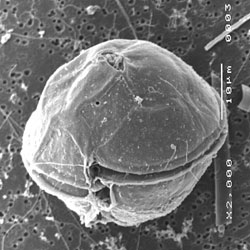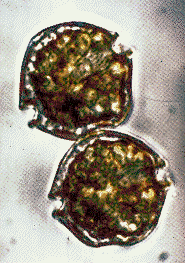Alexandrium tamarense: Difference between revisions
imported>Ciro Monaco Jr. |
imported>Ciro Monaco Jr. |
||
| Line 30: | Line 30: | ||
''Alexandrium tamarense'' is a single-celled dinoflagellate found | ''Alexandrium tamarense'' is a single-celled dinoflagellate found in coastal marine environments throughout the world and is often known as the one of the culprits that causes algal blooms called red tides. It is considered a photoautotroph and contains brown chloroplasts, is 25-46 micrometers in length, | ||
==Genome structure== | ==Genome structure== | ||
Revision as of 07:59, 1 April 2008
Articles that lack this notice, including many Eduzendium ones, welcome your collaboration! |
Classification
Picture courtesy of USGS Woods Hole Science Center
Higher order taxa
Domain: Eukaryota
Phylum: Alveolata
Class: Dinophyceae
Order: Gonyaulacales
Family: Gonyaulacaceae
Species
Alexandrium tamarense
Synonyms: Gonyaulax tamarensis Lebour 1925 , G. excavata (Braarud) Balech 1971 Protogonyaulax tamarensis (Lebour) F. J. R. Taylor 1979
Description and significance
Describe the appearance, habitat, etc. of the organism, and why it is important enough to have its genome sequenced. Describe how and where it was isolated.
Alexandrium tamarense is a single-celled dinoflagellate found in coastal marine environments throughout the world and is often known as the one of the culprits that causes algal blooms called red tides. It is considered a photoautotroph and contains brown chloroplasts, is 25-46 micrometers in length,
Genome structure
Describe the size and content of the genome. How many chromosomes? Circular or linear? Other interesting features?Does it have any plasmids? Are they important to the organism's lifestyle?
Like other dinoflagellates, Alexandrium tamarense consists of large amounts of DNA compared to other eukaryotic organisms. It consists of 144 chromosomes which are condensed in the nucleus until DNA replication. A total of 11,103 nucleotides [218 nucleotide core and 10,885 expressed sequence tags (ESTs)] have been sequenced.
It is still not clear which genes play a role in toxin production.
Cell structure and metabolism
Describe any interesting features and/or cell structures; how it gains energy; what important molecules it produces.
Like other dinoflagellate species, A. tamarense propels itself through water using two flagella in a whip-like fashion. It is also considered "armored" because it is surrounded by a layer of cellulose that form plates known as thecae.
Ecology
Describe any interactions with other organisms (included eukaryotes), contributions to the environment, effect on environment, etc.
Pathology
How does this organism cause disease? Human, animal, plant hosts? Virulence factors, as well as patient symptoms.
Not all strains of Alexandrium tamarense are toxic. Different strains are often found in the same algal blooms caused by this species.
However, some strains of Alexandrium tamarense produce very potent neurotoxins known as paralytic shellfish toxins (PSTs). These toxins, which include gonyautoxins, neosaxitoxin and saxitoxin, affect fish, marine mammals, birds, and humans.
Many deaths have been reported from the consumption of shellfish infected with these toxins.
Resting cysts can harbour PSP toxins, it was been demonstrated that cysts were more toxic than their motile stage. Humans, other mammals, fish and birds can be affected. Please consult original reference for further details. Harmful species http://www.algaebase.org/search/species/detail/?species_id=40299
http://www.nmnh.si.edu/botany/projects/dinoflag/Taxa/Atamarense.htm
Application to Biotechnology
Does this organism produce any useful compounds or enzymes? What are they and how are they used?
Current Research
Enter summaries of the most recent research here--at least three required

